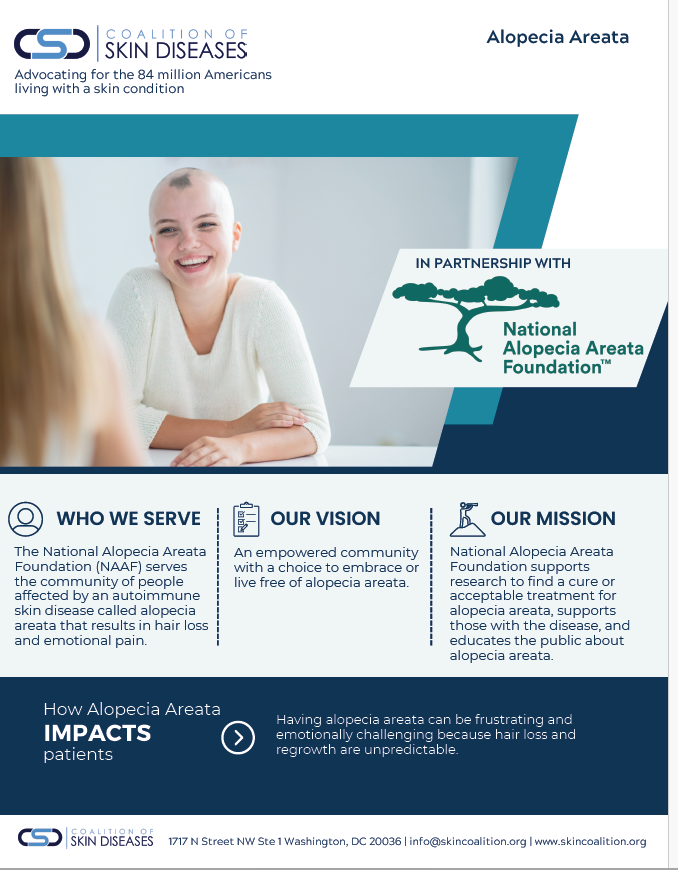Alopecia areata is an autoimmune skin disease resulting in the loss of hair on the scalp and elsewhere on the body. Alopecia areata patchy usually starts with one or more small, round, smooth bald patches on the scalp or elsewhere. Total scalp hair loss is alopecia areata totalis. Complete body hair loss is alopecia areata universalis. Alopecia totalis and alopecia universalis are considered rare diseases.
In alopecia universalis, the most severe form of the disease, all hair on the entire body is lost, leaving it unprotected—scalp from the sun and elements; eyes from dust and glare; and nose and sinuses from foreign particles and bacteria.
Alopecia areata has a cumulative lifetime incidence of 2.1% which translates into 6.8 million people in the US and 147 million worldwide who have, had or will develop alopecia areata at some point in their lives.
Alopecia areata occurs in males and females of all ages and races; however, onset most often begins in childhood and can be psychologically devastating.
Alopecia areata is highly unpredictable and cyclical. Hair can grow back in or fall out again at any time, and the disease course is different for each person.
Due to public unfamiliarity with the disease, alopecia areata can have a profound impact on one’s life and functional status, both at work and at school.
Some persons are more genetically susceptible to developing alopecia areata, which involves multiple genes. Alopecia areata is known as a complex trait disorder.
In at least one out of five persons with alopecia areata, someone else in their family also has it.
Current research has shown that there appears to be genes that confer susceptibility to the disease, as well as the degree of disease severity. Research into the genetics of alopecia areata is currently ongoing. Eight genes related to alopecia areata have been discovered that are related to Type 1 diabetes, rheumatoid arthritis and celiac disease.
Persons with alopecia areata and their families have a higher incidence of other autoimmune disorders such as thyroiditis, Type 1 diabetes, rheumatoid arthritis, vitiligo, celiac disease and lupus. In addition, they are more likely to suffer from allergies, asthma, hay fever, and atopic eczema.
There appear to be two forms of alopecia areata—an early-onset form and a late-onset form. Those who develop their alopecia areata in childhood typically have alopecia totalis or alopecia universalis later in life; this early-onset form is usually more chronic.
NAAF has launched a seven year first phase Alopecia Treatment Development Program to find an acceptable treatment.
Treatment options are limited at the present time and depend upon the extent of hair loss; no one treatment works well for every person. There are no approved drugs by the Food and Drug Administration (FDA) for alopecia areata. Any treatments approved for other diseases and used for alopecia areata have to be used off label.
No treatment, no matter how effective, can prevent new patches of hair loss from developing or affect the ultimate course of the disease. Currently there is no cure for alopecia areata.
Treatment options include cortisone injections or pills, topical application of minoxidil or chemical substances that induce an allergic rash or contact dermatitis; however, these treatments are generally not effective for those with total scalp hair loss and some can have side effects.
Recent research has verified that in alopecia areata, a person’s own white blood cells (T lymphocytes) mistakenly attack the lower portion of the hair follicle, suppressing hair growth.
Identification of the molecular target of the T cell attack inducing inflammation surrounding the hair follicle would make possible the development of specific immunotherapies.

Connect with your federal legislators to speak up for dermatological conditions today.